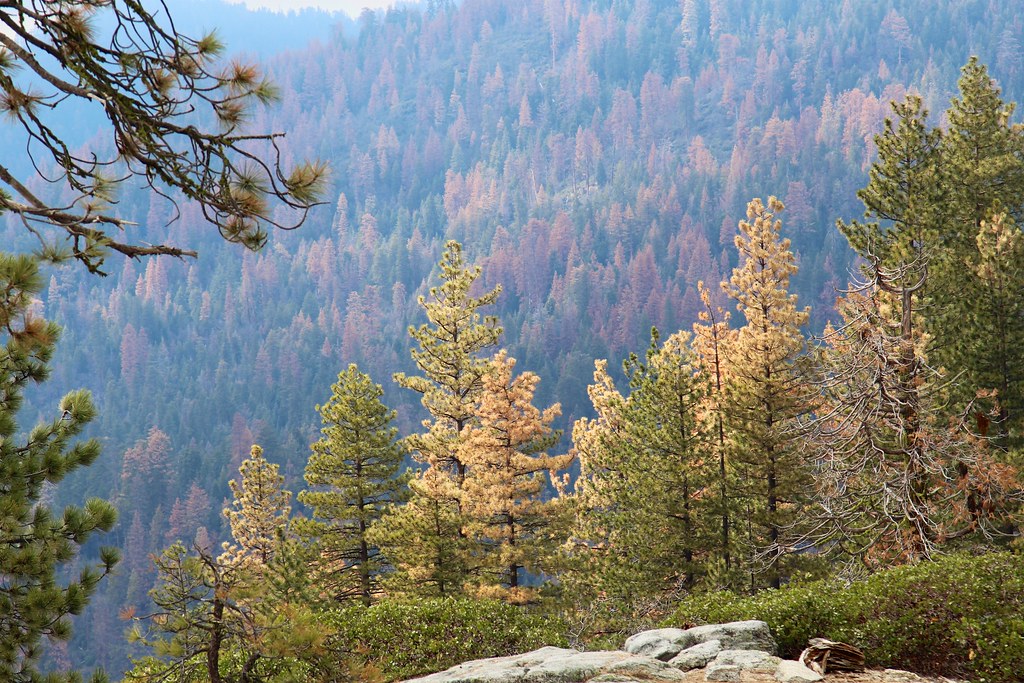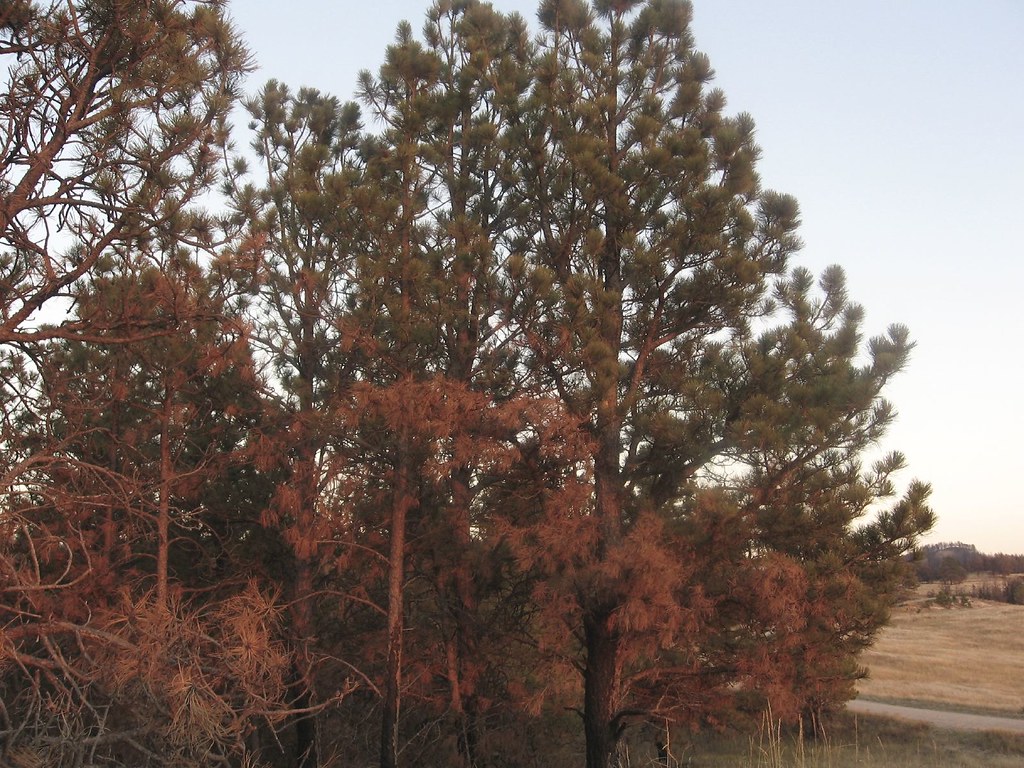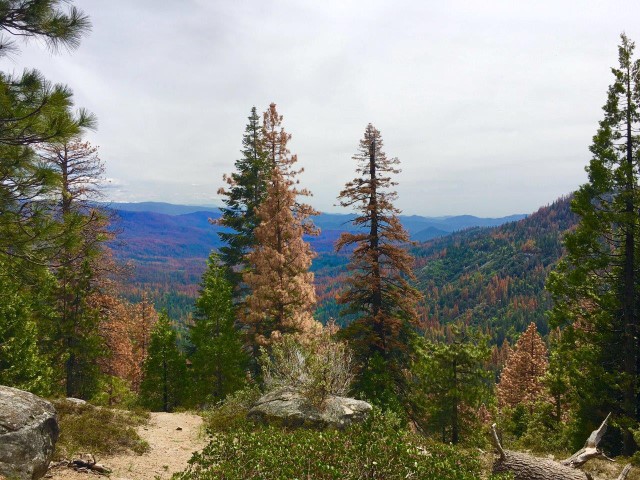A pine tree may die from the bottom up if it is not getting enough water. The roots of the tree are responsible for taking in water and nutrients from the soil, so if they are not able to do this effectively, the rest of the tree will suffer. If you notice that your pine tree is dying from the bottom up, you should try to water it more frequently.
You may also need to check the drainage of the area around the tree to make sure that water is not pooling around its roots.
If you notice that your pine tree is dying from the bottom up, there are a few possible explanations. First, it could be due to a root rot issue. This is caused by too much moisture in the soil, which can lead to fungal growth and eventually kill the roots.
Second, Pine Trees are susceptible to a disease called Needle Cast. This occurs when the needles of the tree turn yellow or brown and fall off. Finally, Pine Trees can also be attacked by pests like aphids, scale insects, or borers, which can cause dieback from the bottom up.
If you’re not sure what’s causing the problem, it’s best to consult with a certified arborist or tree specialist.
Why is My Pine Tree Dying from the Bottom Up?
There are several reasons why a pine tree may die from the bottom up. One common reason is that the tree is not getting enough water. Pine trees need a lot of water, especially during hot summer months.
If the tree isn’t getting enough water, the needles will start to turn brown and fall off. The bark may also start to peel away from the trunk. Another reason why a pine tree may die from the bottom up is because of pests or diseases.
Pine beetles are a common pest that can kill a pine tree. These insects bore into the trunk and eat away at the inner bark. This damages the tree’s ability to transport water and nutrients, causing it to slowly die.
Diseases such as pitch canker can also cause a pine tree to die from the bottom up. Pitch canker is caused by a fungus that invades the trunk through wounds or cracks. The fungus then starts to kill the cells in the inner bark, preventing water and nutrients from flowing properly throughout the tree.
If you think your pine tree is dying from the bottom up, it’s important to contact an arborist or certified forester for help.
How Do You Revive a Dying Pine Tree?
If your pine tree is beginning to show signs of decline, there are a few things you can do to try and revive it. First, check the soil around the tree. Pine trees need well-drained, sandy soil in order to thrive.
If the soil around your tree is compacted or full of clay, it could be causing the roots to suffocate and preventing the tree from getting the nutrients it needs. Use a garden fork or tiller to loosen up the soil around the tree, being careful not to damage any roots in the process. You may also want to add some sand or compost to improve drainage.
Next, take a look at the needles on your pine tree. Needles that are yellow or brownish in color are an indication of stress or disease. Prune away any affected branches and dispose of them properly (do not compost).
If more than half of the needles on your pine tree are discolored, it may be best to remove the entire tree before it has a chance to spread disease to other trees in your yard. Finally, make sure your pine tree is getting enough water. Pine trees require deep watering once per week during periods of active growth (spring and summer).
Water slowly and deeply so that water penetrates down to the root zone (several inches below ground level). If possible, use drip irrigation or soaker hoses instead of overhead sprinklers which can promote fungal diseases like powdery mildew. If you live in an area with especially hot summers, you may need to water more frequently – up to twice per week – during peak growth periods.
Why is Half of My Pine Tree Dying?
If you notice that half of your pine tree is dying, there are several potential reasons why this may be happening. One possibility is that the tree is not getting enough water. Pine trees need a lot of water, especially when they are young, so make sure to give your tree plenty of water if you live in an area with low rainfall.
Another possibility is that the tree is being damaged by insects or diseases. If you see any signs of insect damage (such as holes in the bark or leaves), or if the needles on your tree are turning brown or falling off, it’s possible that your tree is sick and needs to be treated by a professional arborist.
What Does a Dying Pine Tree Look Like?
As a tree begins to die, it will start to show signs of stress. The needles may begin to turn brown and drop off, the bark may start to peel or crack, and the branches may start to die back. Once a tree is severely stressed, it will begin to produce fewer cones and seeds, and the leaves will become smaller.
The tree may also stop growing altogether. As the tree dies, its bark will become thin and papery, eventually falling off entirely. The wood beneath the bark will become dry and discolored, and the tree will slowly rot from the inside out.
Why Is My Pine Tree Dying from the Bottom Up?
How to Save a Dying Pine Tree
When a pine tree begins to die, it is important to take action quickly in order to save it. There are a few things you can do to help a dying pine tree: -Water the tree deeply and regularly, especially during dry periods.
Be sure to soak the root system thoroughly.
- Apply mulch around the base of the tree to help retain moisture. -Prune away any dead or dying branches.
- This will help the tree direct its energy towards new growth.
- Fertilize the tree with an organic fertilizer formulated for trees and shrubs. Follow the directions on the package carefully.
With proper care, you can often save a dying pine tree. However, if the tree is too far gone, it may need to be removed completely in order to prevent further damage to your property.
Spruce Tree Dying from Bottom Up
If you notice your spruce tree dying from the bottom up, there are a few potential causes. It could be due to poor drainage in the area where the tree is planted, which can lead to root rot. Alternatively, it could be caused by a fungal disease called Phytophthora root rot, which is particularly prevalent in wet or humid conditions.
If you suspect that your tree is suffering from root rot, you should contact a certified arborist or tree care professional for diagnosis and treatment recommendations.
Is a Pine Tree Dead When It Turns Brown?
When a pine tree turns brown, it is not necessarily dead. Sometimes, the tree is simply going through a natural process called dormancy. During dormancy, the tree’s leaves will turn brown and fall off as the tree conserves energy for the winter months.
The tree may also drop its cones during this time. However, if the entire tree has turned brown and appears to be dead, it is likely that it has been killed by a pest or disease.
Pine Tree Dying from Inside Out
If you have a pine tree that is dying from the inside out, it is likely due to a few different reasons. First, the tree may be infected with a disease or pest that is causing it to decay from the inside. Second, the tree may not be getting enough water or nutrients, which can cause it to slowly die from the inside out.
Finally, if the tree is located in an area where there are high levels of pollution or chemicals, this can also lead to its slow death. If you think your pine tree is dying from the inside out, it is important to contact a professional arborist or forester who can help diagnose the problem and recommend a course of treatment.
Evergreen Dying from Bottom Up
If you have an evergreen tree that is dying from the bottom up, it is likely due to a root problem. The roots of the tree may be damaged or diseased, which can cause the top of the tree to die. If you think your evergreen tree has a root problem, you should contact a certified arborist or tree surgeon for diagnosis and treatment options.
What to Do With Dead Pine Tree
When a pine tree dies, it can become a hazard if it is not removed properly. If you have a dead pine tree on your property, there are a few things you can do with it. Here are some ideas:
-Remove the tree yourself: This is the most common option for dealing with a dead pine tree. You will need to rent or purchase a stump grinder or chainsaw to remove the tree. Be sure to follow all safety precautions when using these tools.
-Hire someone to remove the tree: If you don’t feel comfortable removing the tree yourself, you can hire someone to do it for you. Many Tree Removal companies offer this service. -Leave the tree: If the dead pine tree is not causing any problems, you may choose to leave it where it is.
Frequently Asked Questions:
What causes dead pine trees?
Dead pine trees can be caused by factors such as diseases, insect infestations, drought, root damage, poor soil conditions, extreme environmental stress, human activities, age, fire, and climate change.
Can I save a dead pine tree?
It’s challenging to save a completely dead pine tree, but if the tree is showing signs of decline, you can consult an arborist to assess the situation. In some cases, early intervention, like pruning, fertilization, or disease/insect control, may help if the tree is not entirely dead.
How do I know if a pine tree is dying?
Signs that a pine tree may be dying include:
Brown or Yellow Needles: Discolored needles on a pine tree, especially on the entire tree or one side, can be a sign of stress or disease.
Needle Loss: Rapid loss of needles, leaving behind bare branches, indicates a problem.
Bark Damage: Bark peeling off or cracks in the bark can be a sign of stress or pest infestations.
Sparse Foliage: Thinning of foliage or a general reduction in greenery can signal declining health.
Conclusion
If you notice a pine tree dying from the bottom up, there are several possible causes. The most common is root rot, which is caused by too much water around the tree’s roots. This can be due to poor drainage in the soil or overwatering.
Other possible causes include damage to the roots from construction or landscaping work, insect infestations, or disease. If you’re not sure what’s causing the problem, it’s best to consult with a certified arborist or other tree expert.
Related Articles:
Insect Invasion: Threat to Utah’s Fir Forests
 Dr Ahsanur Rahman, PHD
Dr Ahsanur Rahman, PHD
UK Forests Collapse Imminent: Act Now Against Climate!
 Dr Ahsanur Rahman, PHD
Dr Ahsanur Rahman, PHD
Lightning Strikes Threat: Boreal Fires Jeopardize Carbon
 Dr Ahsanur Rahman, PHD
Dr Ahsanur Rahman, PHD









